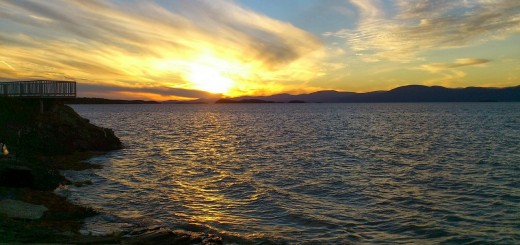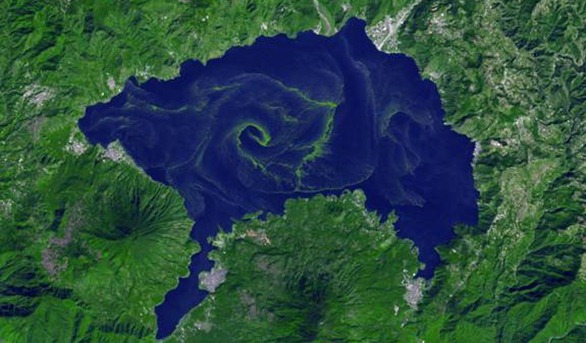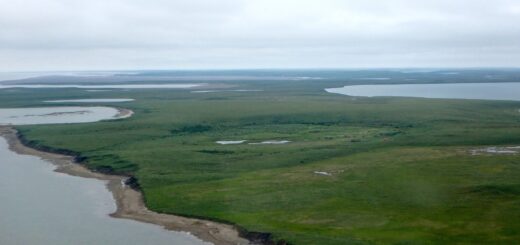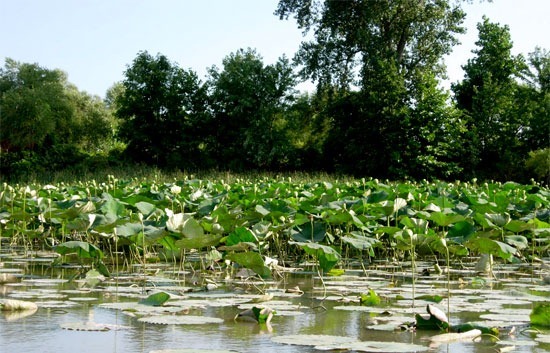Research Brief: Evaluating the Efficacy of No-Wake Zone Policies
0Often introduced in order to protect shorelines from erosion, no-wake zone policies in shallow water bodies have the potential to help minimize the resuspension of sediment, which can lead to a variety of other water quality issues, such as reducing water clarity, light penetration, and ultimately, phytoplankton growth.
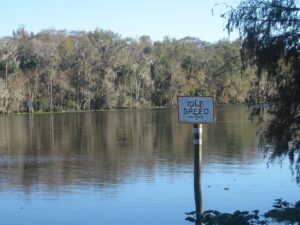
Sign indicating an “idle speed” or “no wake” zone for boaters on the St. Johns River in Astor, Florida, USA. (Credit: TampAGS, / AGS Media via Wikimedia Commons CC BY-SA 3.0)
While the primary driver of sediment resuspension is wind-driven surface waves, boating activity, particularly in shallow waters with looser sediment, can have more severe impacts than in deeper waters with rocky bottoms. Therefore, the efficacy of no-wake zone policies may be influenced by a multitude of variables.
A 2025 study published in Lake and Reservoir Management assessed the effects of boating on shallow waters in order to evaluate the efficacy of current no-wake zone policies.1 The study sought to answer three questions:
- “Does the current no-wake zone policy at Lake Tahoe prevent sediment resuspension events from boating activity?
- What is the contribution of boat-induced waves to Lake Tahoe’s overall wavefield?
- Is the daily turbidity distribution in shallow areas associated with boating activity?”1
Methods
Two experiments were conducted in order to evaluate both the impact of boating activity on sediment resuspension as well as the efficacy of no-wake zone policies.
First, turbidity and pressure data were collected along a broad shallow shelf on the southern shore of Lake Tahoe in the summer of 2019 using sensors deployed along the Timber Cove pier between July and December. Cameras stationed at Heavenly Resort on the southern end of the lake also provided images of boating activity in the vicinity of the pier.
Second, turbidity and pressure observations were conducted during a two-day controlled experiment at Sugar Pine Point on Lake Tahoe in August of 2022. During this experiment, “two boats were driven separately along a prescribed path at speeds between 8 kmh-1 (5 mph) and 40 kmh-1 (25 mph) for a total of 15 boat passages.”1
These speeds were selected due to Lake Tahoe’s no-wake zone policy, which enforces a 5 mph speed limit for boaters near the shoreline.
A set of three turbidity and pressure sensors were deployed in an L-shaped configuration along the boat path, where they recorded data during the experiment on August 29th and August 30th. An underwater camera also recorded sediment resuspension at this time.

(a) Map of Lake Tahoe with 50 m isobaths and experiment study sites at Timber Cove (TB) and Sugar Pine Point (SP). At each study site, the year of the experiment is on top of the location’s name. Circles represent the Nearshore stations, and triangles represent the meteorological data available from the long-term existing infrastructure. (b) Detailed view of field deployment at SP in 2022. (Credit: Valbuena et al., 2024)
Results
Results indicated that turbidity exhibited a spatial-temporal variability throughout the summer and fall, with levels being consistently higher closer to the shore. In 2019, 224 boats were recorded traveling along the pier or near the end of the in-water structure between August 8th and September 3rd and from September 14th to the 15th.
Sensor data revealed the amount of sediment resuspended during these boat passes, with clear increases when boats exceeded the 5 mph no-wake zone policy. However, when following the no-wake zone speed limit, resuspension did not typically occur.
The Sugar Pine Point experiment revealed that boat speeds of 5 mph or less do not cause resuspension over the sandy lakebeds found at Sugar Point.
Results from the two datasets indicate that boat-induced resuspension may occur in the shallow, nearshore zones of Lake Tahoe, depending on water depth and boat velocity. And while wind-induced waves are still the leading driver of resuspension, boating can impact lake turbidity.
Ultimately, Lake Tahoe’s no-wake zone policy is effective at minimizing sediment resuspension. However, the article concludes that there is a need to consider “multiple variables, such as lakebed sediment type and water depth, when defining no-wake zone policies to effectively mitigate boating-induced effects” at other lakes.1
Source
- Valbuena, S. A., Schladow, S. G., & Bombardelli, F. A. (2024). Boat effects on lake water clarity and the efficacy of a no-wake zone policy. Lake and Reservoir Management, 41(1), 16–33. https://doi.org/10.1080/10402381.2024.2388540




